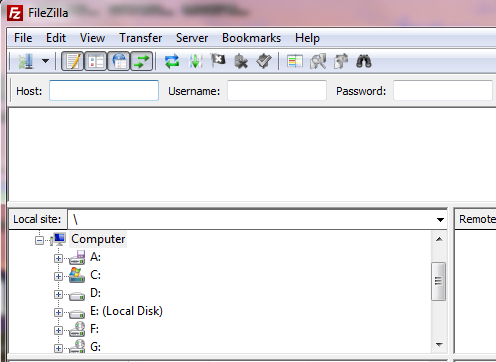

- #FILEZILLA FAILED TO RETRIEVE DIRECTORY LISTING BLUEHOST HOW TO#
- #FILEZILLA FAILED TO RETRIEVE DIRECTORY LISTING BLUEHOST CODE#
You may have to check your provider’s documentation to find it. Hosts that use other control panel interfaces should still provide easy access to this platform.

If your host uses cPanel, you can click on the phpMyAdmin icon under Databases: Step 1: Log in to your hosting account and open phpMyAdminįirst, you’ll need to log in to your hosting account and access phpMyAdmin, the database manager WordPress uses. Some basic knowledge of File Transfer Protocol (FTP) and phpMyAdmin is also handy, but you’re not overly familiar with these tools you should still be able to follow the steps below. In order to manually restore your WordPress website, you’ll need backups of your WordPress files and database saved to your local computer.
#FILEZILLA FAILED TO RETRIEVE DIRECTORY LISTING BLUEHOST HOW TO#
How to manually restore a WordPress website from a backup (In 5 steps) However, manually recovering a broken site is sometimes the most reliable (or only) route available. This process is a bit complicated compared to restoring your site with a plugin or through your hosting account. Then, if all else fails, you’ll always be able to manually restore your WordPress website. If it becomes compromised in some way, both your website and your latest copy could be lost.įor this reason, it’s always wise to save your most recent backup to your own computer or cloud storage account. However, your host may save site backups to the same server that stores your site. It often includes a ‘one-click’ restore option. Many web hosts include backups as part of their plans, while others offer this service as an add-on. Additionally, you may not be able to use the automatic restore option if you’re unable to access the back end of your site.Īnother method is to go through your hosting provider. While these tools can be useful, they’re also sometimes limiting.įor example, you’ll only be able to save your backups using storage options supported by your plugin. One method is to use a plugin such as UpdraftPlus, BlogVault or ManageWP. There are various ways you can create and restore WordPress backups. Common methods for restoring WordPress backups This can then give you time to go about fixing the root of the problem. Restoring a recent backup is often the fastest way to recover from a WordPress disaster.

Regardless of what happens to your site, the important thing is resolving the issue and making sure your content is available to users.
#FILEZILLA FAILED TO RETRIEVE DIRECTORY LISTING BLUEHOST CODE#
Incompatibilities with themes, a plugin vulnerability, or even a user messing with your site’s code could result in a website that’s beyond basic troubleshooting.

You could be well-versed in web development and programming yet still have something unexpected happen to your site. If your website is hacked and defaced by a cybercriminal, for example, having a recent copy lets you salvage your site and return it to its previous state. Let’s get into it! Why you would want to restore your WordPress site from a backupīacking up your WordPress files and database lets you restore them in the event something goes wrong with your site. Then we’ll walk you through how to do so manually in five steps. In this post, we’ll explain when you may need to restore your site from a backup and the methods available for doing so. So long as you have your database and files backed up, you have a way to manually restore your WordPress website.Įditor’s note: It is advisable to always have a secondary backup copy saved on an external destination. When this happens, there’s no better feeling than knowing you have a copy of your site you can use to recover your work. Still, many people don’t realize just how critical they are until they’re dealing with a broken site. In the WordPress community, the importance of regular website backups is stressed routinely.


 0 kommentar(er)
0 kommentar(er)
